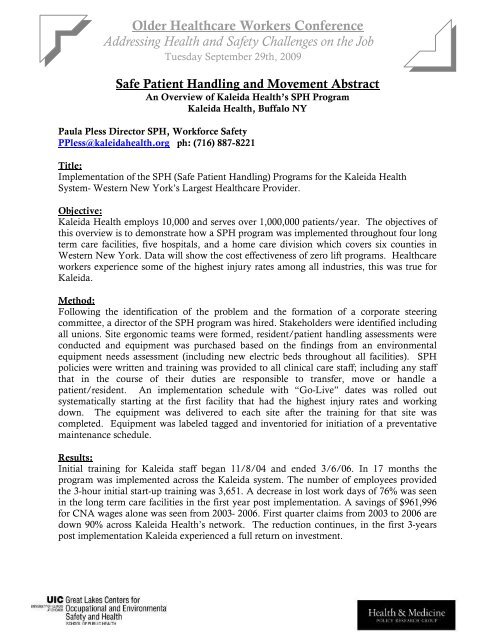Employer Case Examples - Health & Medicine Policy Research Group
Employer Case Examples - Health & Medicine Policy Research Group
Employer Case Examples - Health & Medicine Policy Research Group
Create successful ePaper yourself
Turn your PDF publications into a flip-book with our unique Google optimized e-Paper software.
Older <strong>Health</strong>care Workers ConferenceAddressing <strong>Health</strong> and Safety Challenges on the JobTuesday September 29th, 2009Safe Patient Handling and Movement AbstractAn Overview of Kaleida <strong>Health</strong>’s SPH ProgramKaleida <strong>Health</strong>, Buffalo NYPaula Pless Director SPH, Workforce SafetyPPless@kaleidahealth.org ph: (716) 887-8221Title:Implementation of the SPH (Safe Patient Handling) Programs for the Kaleida <strong>Health</strong>System- Western New York’s Largest <strong>Health</strong>care Provider.Objective:Kaleida <strong>Health</strong> employs 10,000 and serves over 1,000,000 patients/year. The objectives ofthis overview is to demonstrate how a SPH program was implemented throughout four longterm care facilities, five hospitals, and a home care division which covers six counties inWestern New York. Data will show the cost effectiveness of zero lift programs. <strong>Health</strong>careworkers experience some of the highest injury rates among all industries, this was true forKaleida.Method:Following the identification of the problem and the formation of a corporate steeringcommittee, a director of the SPH program was hired. Stakeholders were identified includingall unions. Site ergonomic teams were formed, resident/patient handling assessments wereconducted and equipment was purchased based on the findings from an environmentalequipment needs assessment (including new electric beds throughout all facilities). SPHpolicies were written and training was provided to all clinical care staff; including any staffthat in the course of their duties are responsible to transfer, move or handle apatient/resident. An implementation schedule with “Go-Live” dates was rolled outsystematically starting at the first facility that had the highest injury rates and workingdown. The equipment was delivered to each site after the training for that site wascompleted. Equipment was labeled tagged and inventoried for initiation of a preventativemaintenance schedule.Results:Initial training for Kaleida staff began 11/8/04 and ended 3/6/06. In 17 months theprogram was implemented across the Kaleida system. The number of employees providedthe 3-hour initial start-up training was 3,651. A decrease in lost work days of 76% was seenin the long term care facilities in the first year post implementation. A savings of $961,996for CNA wages alone was seen from 2003- 2006. First quarter claims from 2003 to 2006 aredown 90% across Kaleida <strong>Health</strong>’s network. The reduction continues, in the first 3-yearspost implementation Kaleida experienced a full return on investment.


